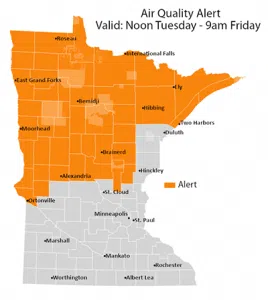 The Pollution Control Agency has issued an air quality alert for northern Minnesota through Friday morning.
The Pollution Control Agency has issued an air quality alert for northern Minnesota through Friday morning.
The affected area includes the Lakes Area as well as Bemidji, Roseau, Moorhead, East Grand Forks, Brainerd, Alexandria and the tribal areas of Grand Portage, Leech Lake, Mille Lacs, and Red Lake.
Smoke from wildfires located north of the Canadian border in Ontario and Manitoba will be transported by northerly winds behind a front moving into the northern portions of the state. Heavy smoke is expected to arrive Tuesday and remain over the area into Friday morning. During this time, fine particle levels are expected to be in the Red AQI category, a level considered unhealthy for all individuals, across far northern Minnesota and Orange, a level that is considered unhealthy for sensitive groups, across western and central Minnesota. In addition to the smoke behind the front Tuesday, additional smoke is expected over western Minnesota Wednesday evening following a forecasted complex of thunderstorms. The smoke will remain over Minnesota through at least Friday before southerly winds develop and push the smoke northward.
People whose health is affected by unhealthy air quality: There are people who are more likely to be affected when ozone pollution reaches an unhealthy level.
- People who have asthma or other breathing conditions like chronic obstructive pulmonary disease (COPD), chronic bronchitis, and emphysema.
- Children and teenagers.
- People of all ages who are doing extended or heavy, physical activity like playing sports or working outdoors.
- Some healthy people who are more sensitive to ozone even though they have none of the risk factors. There may be a genetic base for this increased sensitivity.
- Health effects: Unhealthy ozone levels can aggravate lung diseases like asthma, emphysema, and COPD. When the air quality is unhealthy, people with these conditions may experience symptoms like difficulty breathing deeply, shortness of breath, throat soreness, wheezing, coughing, or unusual fatigue. If you are experiencing any of these symptoms, use your inhalers as directed and contact your health care provider.
Take precautions: Everyone should take precautions when the air quality is unhealthy.
- Take it easy and listen to your body.
- Limit, change, or postpone your physical activity.
- If possible, stay away from local sources of air pollution like busy roads and wood fires.
- If you have asthma, or other breathing conditions like COPD, make sure you have your relief/rescue inhaler with you.
- People with asthma should review and follow guidance in their written asthma action plan. Make an appointment to see your health provider if you don’t have an asthma action plan.
Pollution reduction tips: Ozone is produced on hot, sunny days by a chemical reaction between volatile organic compounds and oxides of nitrogen.
- Reduce vehicle trips and fill-up the gas tank at dawn or dusk.
- Encourage use of public transport, or carpool, when possible.
- Postpone use of gasoline powered lawn and garden equipment on air alert days. Use battery or manual equipment instead.
- Avoid backyard fires.

Latest News








